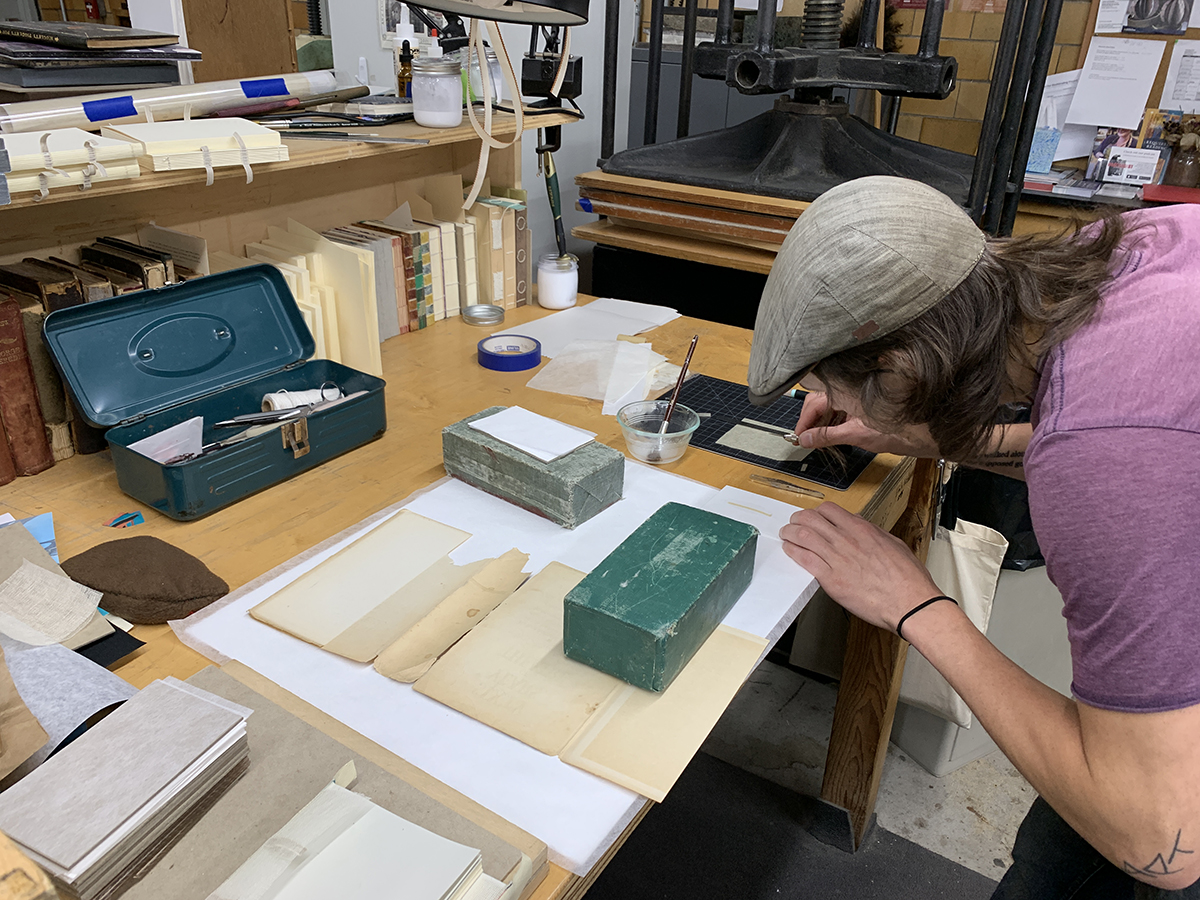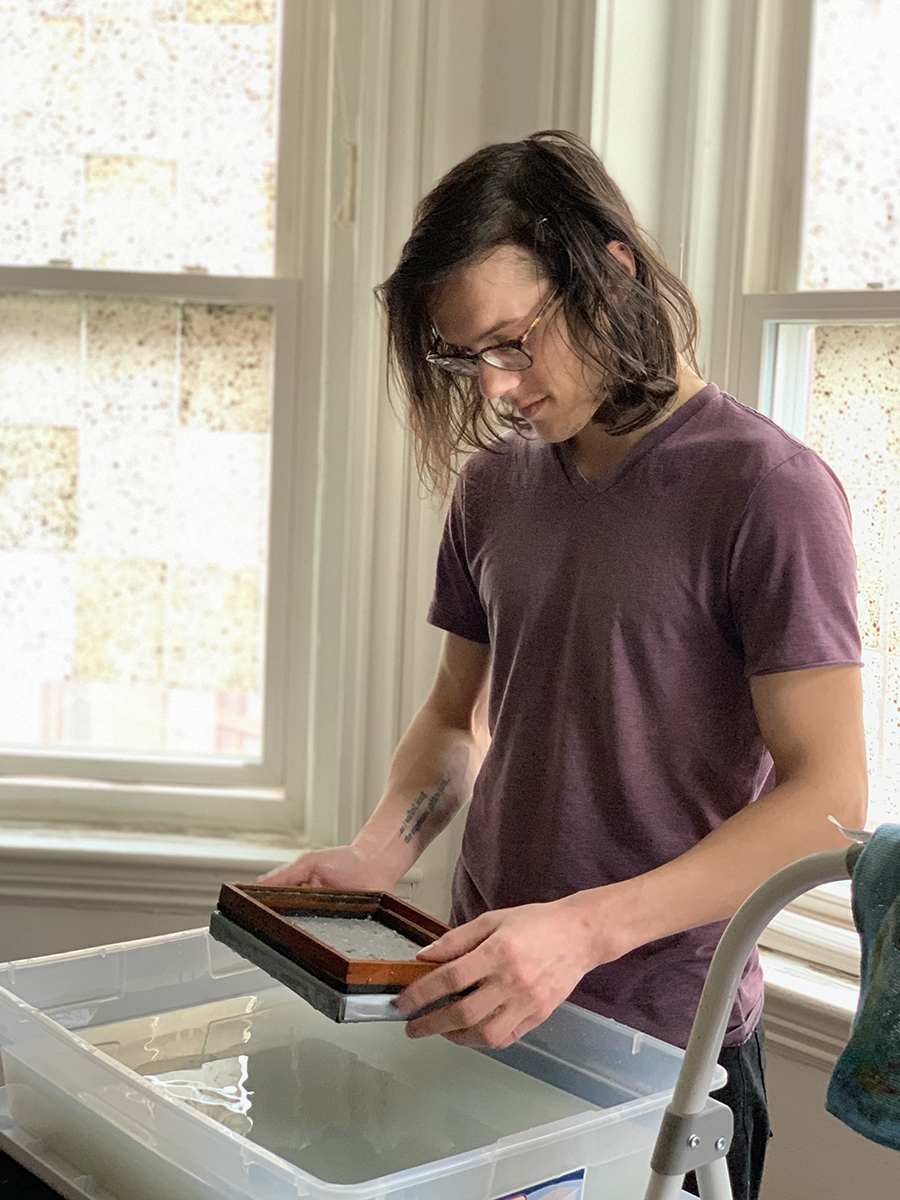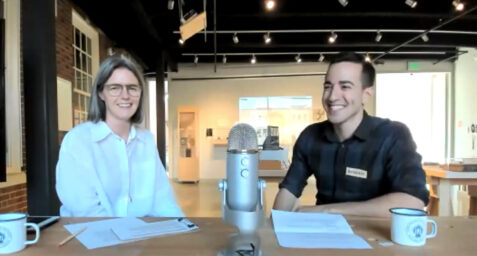In the Making: Mitch Gundrum
“I think stretching the limits of what’s comfortable is almost always valuable.”
North Bennet Street School teaches how to make each component of something—to build and shape from the ground up.
Mitch Gundrum works this way. While he brings his prior education to his daily practice, he also is making paper and hand-shaping Delrin bookbinding folders and tools. Much like a farm-to-plate chef, each step is crafted and controlled, from the exact shape folder he needs to the sizing in the handmade paper.
When NBSS program spaces closed in March, I watched Mitch leave the building loaded up head to toe with borrowed paper-marbling equipment. To seize the unknown by looking around and grabbing exactly what you know you’ll need to keep making—that is a gift that craftspeople have. Watching Mitch walk out the front doors, I thought to myself, “he knows what to do.”
And so he has. He marbled and made paper (with an assist from a cat and a clothes rack). Taking advantage of the space and time to marble away, Mitch also embraced the research and academia as part of the Bookbinding program’s shift to online learning during this time.
Below is an excerpt from the conversation, edited for space and clarity.

Mitch Gundrum: When that announcement to close came, I looked at the collection of marbling supplies in the bindery and I looked at [fellow Bookbinding student] Jane and did a little eye movement—”Let’s grab that stuff.” We grabbed the marbling tray, a bunch of combs and cut a bunch of paper and strips. As much as we could get.
We had recently done a workshop with Chena River (Paper Marblers) and they supply all of the paints. This moment gave us the chance to make our own paints and experiment.
KO: Sounds like you’re doing things that you otherwise wouldn’t be doing.
MG: Yeah, and Jeff (Altepeter, Department Head) has been sending us videos from The Guild of BookWorkers. They have a huge collection of videos and demos from all of their meetings throughout the years which they temporarily made free so people can stay connected to the community.
KO: That’s excellent. Good on them.
MG: Chockablock with new information even if we can’t dig into it at our benches.

KO: Have you enjoyed that remote component to your learning?
MG: It’s all really important context for all of the bench work that we’re doing, so it’s not isolated. I feel that it’s an opportunity to branch into the more academic, epidemiological side of things as opposed to the hands on things. You can separate them in a way but not completely.
Everything that we do at our bench is informed by centuries of process, research, and discovery.
KO: So from that perspective, it’s going to make your base of knowledge stronger.
MG: Yeah. And people get to dive in a little bit more. I’m really excited for our research project.
I have many tidbits of knowledge on the history of paper, but I’ve never seen a full timeline or infographic on the entire history as it relates to books specifically, so I’m planning to work on something like that.
KO: That is great. I’m sure there are some people who would prefer to be at their bench 24 hours a day, you know?
MG: Yes, and there was maybe a little bit of discontent when that came out. That being said, I think stretching the limits of what’s comfortable is almost always valuable.
KO: That’s true. In these interviews, we’ve discussed having to force yourself to be uncomfortable and do things that go against what is learned. It’s forced discomfort and we’ll all learn from it.

MG: Yeah. The potential for new ideas that we never would’ve come up with if we had just been in the classroom these past few weeks. At your home studio, you’re forced to come up with ways of doing what you’re used to without the tools that you normally have available, and that’s where innovation comes from. So it’s not necessarily ideal but I certainly don’t think it’s a waste—or it doesn’t have to be.
KO: Yeah, creative disruption…You also now have time to sharpen your knives, make your Delrin folders, check that list off.
MG: You’ve got to have a sharp knife and unfortunately, it’s one of those things where in between all the other book making steps you say, “All right, it’s time to pair the leather,” I quick strop it, and spend a tenth of the time that you should spend on it just so that you can move on to the next step. But it’s a tool that should be regularly kept up, and now we have plenty of time to do that.
KO: Let’s discuss papermaking. What are the orbs of dried paper that you make?
MG: The ball is stock that I made but wasn’t quite ready to use. I pushed all the water out of it and let it dry on the window sill. Once dried, you just add water! It’ll slowly separate and break up, turn itself back into a bath and I can run a frame through it.
KO: Is the proprietary component how you blend the paper or is it how you use the tray? I ask because if you were ever to create a paper making kit of the ball, the frame and your instructions—I’d like to buy one please!

MG: Haha! Yeah, absolutely. The materials are proprietary and there’s definitely a degree of technique to getting regularity between sheets. There’s definitely a pulp:water recipe for achieving really consistent results. I’ve gotten used to making a big batch with pretty consistent results.
There’s certainly potential to create a kit.
KO: When I see the ball shape, I think of a kit that you would receive in a beautiful box with a note: “Here’s this magical ball and this frame—follow these instructions and you can have a piece of paper!”
MG: With a nice ribbon on it!
KO: Yes, exactly. Plus it is recycled content which is a great selling point.
MG: Yeah, Everything I’ve been using is recycled. I would love to use plant fibers and make something like Japanese tissue for example, which uses six, eight, ten inches long fibers. I am reprocessing processed paper, leaving me only a couple of centimeters of fiber. This means the paper doesn’t have as much fold strength. But yeah, I am turning things into other things.
KO: I’m looking forward to seeing you all back in the fall!
Thank you for your time. Happy marbling.
MG: Yeah, thank you. See you.
Check out Mitch’s handmade Bookbinding tools in the NBSS Online Store.
“In the Making” is a series of video interviews with members of our community where we get insight to their lives and work. Learn more about the conversations, and view a full list of interviews on the series homepage.

